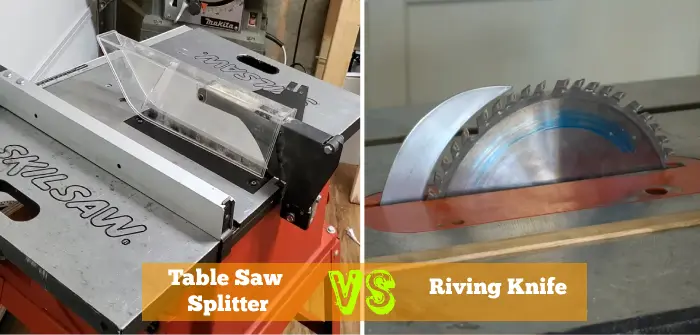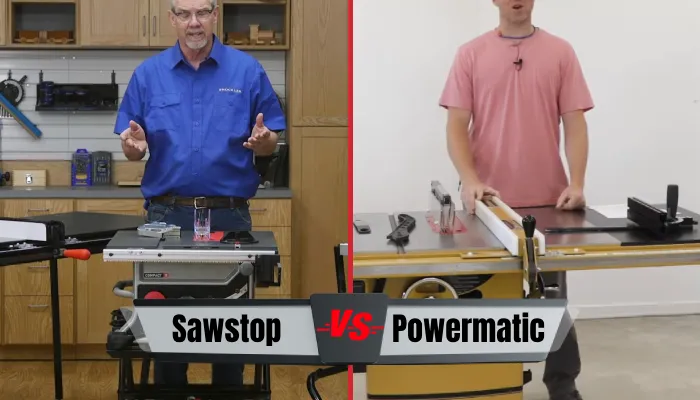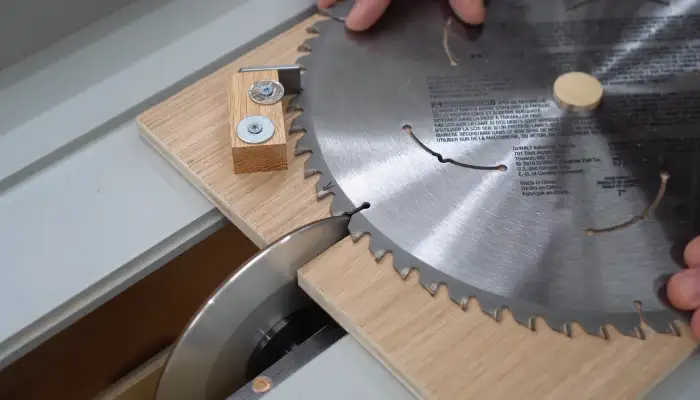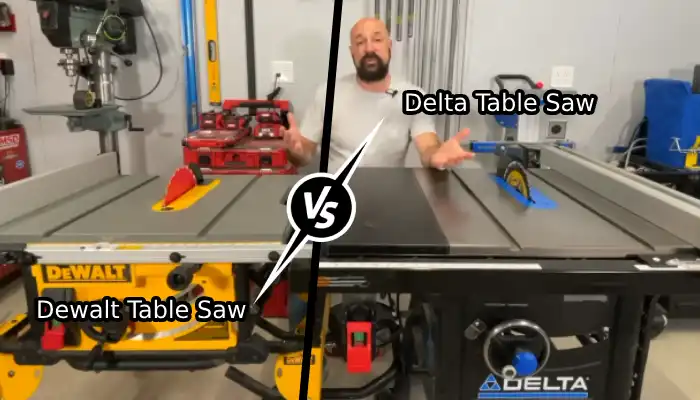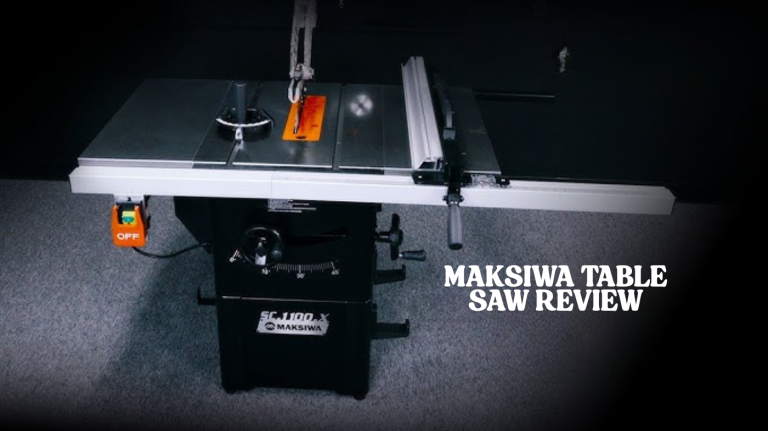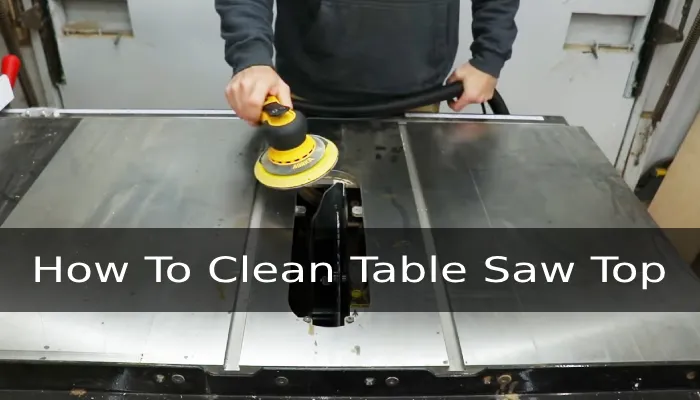Table Saw Splitter vs Riving Knife: 5 Key Differences
For accurate and safe table saw operations, many woodworkers use either a table saw splitter or a riving knife. Both components play a critical role in preventing kickback and ensuring a smooth, precise cut.
However, there are some differences between these two safety tools that can impact the quality of your woodworking projects. Based on my research, one main difference between a table saw splitter and a riving knife is their adjustability.
A splitter typically remains at a fixed height, potentially compromising safety during certain cuts. In contrast, a riving knife is adjustable, ensuring a consistent distance from the back of the blade.
I will explain all the differences in detail to help you determine which option is most appropriate for your specific woodworking requirements.
- Easy Installation, Fool-Proof Alignment
- Robust Stainless Steel Core
- Double Splitter System for Safety
- Automatic Kerf Keeper for Hardwoods
- Precision Engineered, Minimizes Kickback
- Precision safety for table saws
- Reduces kickback and binding
- Easy to install and adjust
- Compatible with various saw models
- Durable construction for long-term use
5 Differences Between Table Saw Splitter and Riving Knife
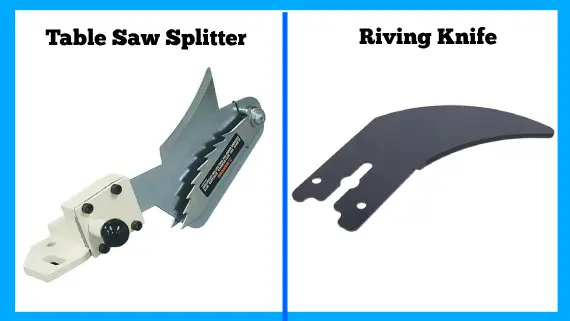
I found five key differences between a table saw splitter and a riving knife that are worth noting, including:
- Adjustability and height
- Versatility in cuts
- UL requirement
- Incorporation into the blade guard
- Ease of retrofitting
1. Adjustability and Height
Regarding adjustability and height, the splitter and riving knife show notable differences. A splitter typically remains fixed in height, which can be effective, but only up to a certain point. As the blade is lowered, a larger gap may emerge between the splitter and blade, ultimately compromising safety during certain cuts.
In contrast, a riving knife is adjustable, allowing you to match its height with the blade’s height. This feature ensures that the riving knife maintains a consistent distance from the back of the blade, providing continuous protection even during both high and low cuts.
If you’re considering enhancing safety and precision in your table saw operations, adding a riving knife to your table saw is a valuable option to explore.
2. Versatility in Cuts
While both the splitter and the riving knife effectively prevent kickback during standard cuts, they differ in versatility for non-through cuts. Splitters need removal when you need to make non-through cuts like dadoes, grooves, and rabbets. As a result, it makes them less versatile.
Conversely, riving knives positioned just below the blade’s top eliminate the need for removal, making them versatile and convenient for a wide range of woodworking tasks. Therefore, regarding versatility in cuts, the riving knife is more versatile than the splitter.
3. UL Requirement
Underwriters Laboratories (UL) made riving knives a requirement for new table saw models introduced in January 2008, while existing models without riving knives were grandfathered until 2014. This standard highlights the safety benefits associated with riving knives.
Therefore, the riving knife is required in new table saw models because of its safety features. It is also an important consideration when purchasing a new saw ensuring you have the latest safety standards in place.
On the other hand, splitters remain a safety upgrade that might be worth considering for older table saw models that do not have a riving knife feature.
4. Incorporation Into Blade Guard
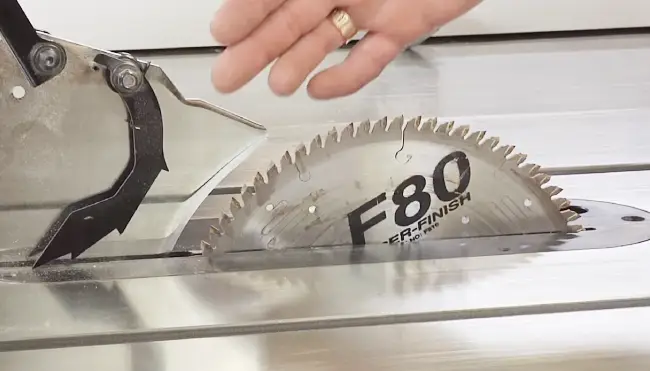
Blade guards are a common element of most table saws, and splitters are typically associated with them. However, splitters can present certain challenges as they are usually stationary and may not be suitable for non-standard cuts.
Riving knives, on the other hand, are often integrated into a larger blade guard system. High-profile riving knives are especially useful as they are designed to work for through-cuts and add an extra layer of safety.
With riving knives integrated into blade guards, you can rest assured that you are working with a safer and more effective tool.
5. Ease of Retrofitting
Retrofitting a table saw splitter to an existing model is often a straightforward process, providing you with an accessible option to enhance safety. Splitters are typically designed to be retrofitted onto older table saws, making it easier for users to add this safety feature to their equipment.
With the right tools and instructions, users can easily install a splitter, ensuring that the blade is properly protected and reducing the risk of kickback.
On the other hand, retrofitting a riving knife to an existing table saw may be more challenging. This is because riving knives require precise alignment with the blade and the saw’s specific design. It may require more technical expertise and adjustments to retrofit a riving knife onto a table successfully saw.
Table Saw Splitter and Riving Knife Comparison Chart
| Aspect | Splitter | Riving Knife |
| Adjustability and Height | Typically fixed height, potentially compromising safety | Adjustable, matches blade height, maintains consistent distance |
| Versatility in Cuts | Effective for standard cuts; may need removal for others | Eliminates need for removal in non-through cuts; versatile |
| UL Requirement | Grandfathered until 2014 for existing models | Required for new models since January 2008; safety emphasis |
| Incorporation into Blade Guard | Commonly associated with blade guards | Often integrated into larger blade-guard system for safety |
| Ease of Retrofitting | Often retrofittable to existing saws | More challenging due to precise alignment and specific design |
What is the recommended thickness for a table saw splitter and riving knife?
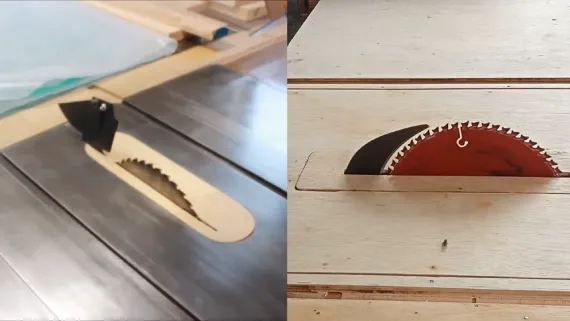
For optimal safety and effective prevention of kickback on your table saw it’s recommended to use a splitter or riving knife that’s slightly thinner than the thickness of your blade kerf.
A popular and versatile option is a thickness of 0.090 inches, suitable for both thin kerf and standard kerf blades. This ensures that the splitter or riving knife effectively maintains the kerf width, reducing the risk of binding and kickback during various cuts.
Choosing the right thickness is crucial for enhancing the overall safety and performance of your table saw. The 0.090-inch option provides a balanced solution for users using different types of blades.
Can you put a riving knife on an older table saw?
Incorporating a true riving knife can present significant engineering challenges if you have an older table saw with a blade that swings on a pivot. Most older saws make it nearly impossible to achieve a true riving knife setup due to the uneven ascent of the blade caused by its pivot mechanism.
While you can fit a splitter to address some safety concerns, retrofitting an older table saw with a riving knife might be challenging or impractical.
Newer saws often feature a front and back riser mechanism, allowing for a more uniform and effective integration of a riving knife. Therefore, if you own an older table saw, installing a true-riving knife may be difficult due to design limitations inherent in these models.
Make a Safe Choice Between Table Saw Splitter and Riving Knife
Understanding the differences between a table saw splitter and a riving knife will help in ensuring safety and efficiency when using a table saw. While both prevent kickback, a riving knife offers more versatility and precision, as I described in detail.
From its adjustable height to the seamless incorporation into blade guards, the riving knife emerges as a safety-centric choice.
Consider these factors when choosing between the two, considering the specific needs of your woodworking projects. Stay informed and prioritize safety to prevent any potential table saw-related injuries and have a smoother table saw experience.
- Prevents Kickback on Table Saws
- Voted Best Tool for Safety
- Installs on Zero Clearance Inserts
- Mini-featherboard Technology for Precision
- Designed for Thin Kerf Saw Blades
- Genuine OEM Replacement Part
- Precision Fit for DWE7491RS Models
- Durable Steel Construction
- Exact Dimensions: 7.25 x 2.85 x 0.1 inches
- Manufactured by Dewalt in the USA
Last update on 2025-11-08 / Affiliate links / Images from Amazon Product Advertising API

